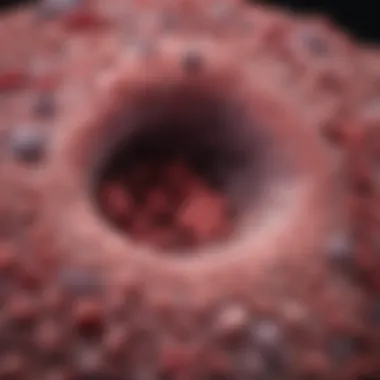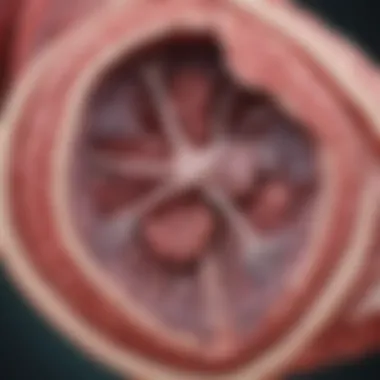Cholangiocarcinomas: Insights into Biliary Tract Cancers


Intro
Cholangiocarcinoma represents an intricate challenge in oncology. It encompasses a variety of malignant tumors originating from the epithelium of the bile ducts. Knowledge about this cancer type is crucial, as its complexity merits a thorough understanding both for clinicians and researchers alike.
The disease is primarily classified into two categories: intrahepatic and extrahepatic cholangiocarcinomas. Each category exhibits distinct biological behavior and clinical characteristics, which are pivotal for accurate diagnosis and effective treatment.
Comprehending cholangiocarcinomas involves delving into several factors: the pathophysiology of the tumor, the diagnostic challenges that arise, available treatment options, and ongoing research efforts aimed at elucidating the nuances of this disease. Furthermore, it is imperative to investigate epidemiological trends and the importance of early detection to improve patient outcomes.
This article aims to guide readers through these topics by offering a well-rounded perspective. Assessing the complexities surrounding cholangiocarcinomas not only enriches our understanding of this type of cancer but also emphasizes the need for continued research in the field.
Prelude to Cholangiocarcinomas
Cholangiocarcinomas present a complex challenge in the field of oncology. Understanding these tumors is crucial for several reasons. They are often diagnosed at advanced stages, which complicates treatment options and shrinks survival rates. Early recognition of symptoms and risk factors can lead to more effective interventions. This section introduces cholangiocarcinomas, outlining their importance in the medical landscape.
Definition and Overview
Cholangiocarcinoma is a type of cancer that arises from the epithelial cells lining the bile ducts. These cancers can be classified broadly into two categories: intrahepatic and extrahepatic cholangiocarcinomas. Intrahepatic cholangiocarcinomas emerge within the liver, while extrahepatic types develop outside the liver, including perihilar and distal variants. Each type has distinct biological behaviors, risk factors, and clinical outcomes.
The tumors may be further categorized based on their histological characteristics. These characteristics play a role in determining the best treatment strategies. Exact diagnosis can be critical, as misclassification can lead to inappropriate management. The complexities surrounding these tumors demand a multi-disciplinary approach for optimal patient care.
Epidemiology and Incidence
Understanding the epidemiology of cholangiocarcinoma is vital. Studies indicate that the incidence of this cancer is increasing globally. Factors that contribute to its rising prevalence include increased awareness and better diagnostic techniques.
Globally, cholangiocarcinoma varies in incidence across regions. For example, Southeast Asia reports higher rates, often due to endemic liver fluke infections leading to chronic inflammation. In contrast, Western countries have a lower but rising incidence, often associated with underlying liver diseases like cirrhosis.
Key points about the epidemiology include:
- The overall incidence over the past few decades has shown an upward trend, suggesting a growing public health concern.
- Specific populations, particularly those with chronic liver diseases, exhibit higher risks of developing cholangiocarcinomas.
- Surveillance strategies are becoming essential, especially in at-risk groups.
"The rising incidence of cholangiocarcinoma underscores the need for enhanced awareness and early detection strategies across diverse populations."
"The rising incidence of cholangiocarcinoma underscores the need for enhanced awareness and early detection strategies across diverse populations."
Recognizing these trends assists in resource allocation and targeted prevention efforts, ensuring that healthcare providers can adapt accordingly.
Pathophysiology of Cholangiocarcinomas
Understanding the pathophysiology of cholangiocarcinomas is vital for grasping how these cancers develop and progress. This section delves into the cellular origin, classification, and the genetic and molecular characteristics of these malignancies. Knowledge of these elements is not only essential for researchers but also for clinicians aiming to optimize treatment strategies and improve patient outcomes. The complexity of cholangiocarcinomas lies in their diverse cellular origins and the interplay of genetic factors that influence tumor behavior.
Cellular Origin and Classification
Cholangiocarcinomas arise from the epithelial cells of the bile ducts, which can be categorized based on their anatomical location into intrahepatic and extrahepatic types. Intrahepatic cholangiocarcinoma originates within the liver, while extrahepatic cholangiocarcinoma occurs outside the liver. Each subtype presents unique histopathological features and clinical behavior.
The classification of these tumors informs both prognosis and therapeutic approaches. For instance, the intrahepatic variant often has a better prognosis compared to the perihilar or distal extrahepatic cholangiocarcinomas.
This distinction is vital, as treatment options such as surgery, chemotherapy, and radiation can vary significantly based on tumor location and type.
Genetic and Molecular Characteristics
The genetic landscape of cholangiocarcinomas reveals crucial insights into their pathogenesis. Genetic mutations and alterations play a key role in the initiation and progression of these cancers.
Common Genetic Mutations
Common genetic mutations that are prevalent in cholangiocarcinomas include mutations in the KRAS, ID, and TP53 genes. These alterations significantly contribute to the molecular characterization of the tumor.
The key characteristic of these mutations is their role in disrupting normal cellular signaling pathways, leading to uncontrolled cell growth. The prevalence of KRAS mutations in some cholangiocarcinomas makes them an attractive focus for personalized treatment approaches, such as targeted therapies.
However, the unique feature of these mutations varies across tumor types, with some being more common in intrahepatic variants compared to extrahepatic ones. Despite their potential for targeted treatments, mutations like TP53 often indicate a worse prognosis, highlighting the need for a tailored treatment strategy.
Role of Oncogenes and Tumor Suppressor Genes
Oncogenes and tumor suppressor genes heavily influence the pathophysiology of cholangiocarcinomas. Oncogenes such as KRAS serve as potent triggers for oncogenesis when mutated, leading to cell proliferation and tumor formation. Conversely, tumor suppressor genes like TP53, when inactivated, fail to regulate cell cycle and apoptosis, resulting in increased tumor viability.
The key characteristic of focusing on these genes is their direct involvement in the cancer's growth and development. Understanding the mutations in oncogenes and the loss of function in tumor suppressor genes is crucial for identifying potential therapeutic targets.


The unique feature of this aspect lies in its dual role; while oncogenes promote cancer growth, the absence of tumor suppressor genes facilitates survival of the malignant cells.
Conclusively, investigating the genetic and molecular landscape of cholangiocarcinomas presents vital opportunities for the design of novel treatments and improves the understanding of disease mechanisms.
"A thorough exploration of the pathophysiological aspects of cholangiocarcinoma opens pathways to innovative diagnostic and therapeutic strategies."
"A thorough exploration of the pathophysiological aspects of cholangiocarcinoma opens pathways to innovative diagnostic and therapeutic strategies."
By grappling with the cellular origins, classification, and genetic underpinnings of cholangiocarcinomas, we lay a fundamental groundwork for the subsequent discussions on risk factors, clinical presentation, and the latest treatment modalities.
Risk Factors and Associations
Understanding the risk factors and associations of cholangiocarcinomas is crucial for prevention and early detection. The complexities of these cancers stem from their relationship with various underlying conditions and exposures. Identifying these risk factors allows healthcare professionals to develop targeted screening protocols, ultimately improving patient outcomes. In this section, we will discuss two significant areas: chronic liver disease along with infection, and environmental and occupational exposures.
Chronic Liver Disease and Infection
Chronic liver disease significantly increases the risk of developing cholangiocarcinoma. Conditions such as cirrhosis and primary sclerosing cholangitis play a central role here.
- Cirrhosis is often the result of long-standing liver diseases, such as chronic hepatitis B and C infections. The liver's continual damage and subsequent scarring can predispose individuals to malignancies, including cholangiocarcinoma. The risk is magnified when accompanied by other associated factors, such as alcohol consumption or metabolic disorders.
- Primary sclerosing cholangitis (PSC) is particularly noteworthy. This chronic inflammatory condition affects the bile ducts, leading to strictures and eventually cholangiocarcinoma. It is often associated with autoimmune diseases like ulcerative colitis.
Infections caused by parasites, such as Clonorchis sinensis, are also a notable risk factor in certain geographic regions, especially in Southeast Asia. These liver flukes can lead to chronic inflammation and subsequent malignancy.
"Chronic liver conditions are significant risk factors for cholangiocarcinoma, highlighting the need for surveillance in high-risk populations."
"Chronic liver conditions are significant risk factors for cholangiocarcinoma, highlighting the need for surveillance in high-risk populations."
Environmental and Occupational Exposures
Environmental and occupational exposures constitute another critical dimension of risk. Certain chemicals and substances have been linked to an elevated incidence of biliary tract cancers. Industries that work with chemical solvents or heavy metals are often scrutinized for their cancer risk contributions.
- Arsenic, commonly found in contaminated drinking water, has been shown to increase cholangiocarcinoma risk. Regions where arsenic exposure is prevalent demonstrate higher rates of these cancers.
- Aniline dyes workers have also been observed to have a higher incidence of biliary cancers. The chemicals in these dyes can induce DNA damage, causing mutations conducive to cancer development.
- Chronic exposure to certain pesticides and heavy metals is linked to various cancers, including cholangiocarcinoma. Understanding specific industries and practices that involve these substances is vital for implementing effective occupational health policies.
In summary, both chronic liver disease and environmental exposures serve as significant contributors to the risk profile for cholangiocarcinomas. Being aware of these factors is paramount for both prevention and the establishment of effective screening strategies.
Clinical Presentation and Diagnosis
The clinical presentation of cholangiocarcinomas is critical for timely diagnosis and effective intervention. Recognizing the symptoms and signs associated with this cancer type can facilitate early detection, which is essential for improving overall prognosis. Patients often present with vague symptoms, making it challenging to pinpoint cholangiocarcinoma at its onset. Clearly understanding these clinical manifestations significantly impacts treatment outcomes.
Symptoms and Signs
Cholangiocarcinomas may present with a variety of symptoms. The most common include:
- Jaundice: A yellowing of the skin and eyes, indicating bile duct obstruction.
- Abdominal pain: Often located in the upper right quadrant, this may be due to tumor pressure.
- Weight loss: Unexplained weight loss can be a sign of malignancy.
- Itching: Due to bile accumulation in the bloodstream.
- Fever and chills: These can occur with associated infections or complications.
Recognizing these symptoms early is vital, as they may not be specific to cholangiocarcinoma. A combination of these signs should signal the need for further investigation, potentially leading to early intervention.
Diagnostic Imaging Techniques
The advancement of imaging techniques plays a fundamental role in diagnosing cholangiocarcinomas. These methods allow for visualization of the bile ducts and surrounding structures, aiding in identifying tumors.
Ultrasound
Ultrasound serves as a non-invasive and accessible initial imaging modality. Its primary strength lies in detecting biliary obstructions and assessing liver status. Percutaneous biopsy can also be performed under ultrasound guidance. One key characteristic of ultrasound is its ability to provide real-time imaging. This aspect makes it particularly beneficial in practice. However, its effectiveness may be limited in evaluating small tumors or distinguishing between benign and malignant lesions.
CT and MRI Scans
CT and MRI scans are invaluable in providing detailed images of the biliary system and surrounding anatomy. These techniques excel in assessing the extent of the disease and detecting metastasis. One unique feature of CT is its ability to depict complex anatomy quickly, which is advantageous in emergency situations. MRI, on the other hand, offers superior soft tissue contrast, making it a preferred choice in specific cases. Both modalities have their advantages and disadvantages; for example, while CT is faster, MRI is often more sensitive in identifying certain tumors.
Endoscopic Techniques
Endoscopic techniques, including Endoscopic Retrograde Cholangiopancreatography (ERCP), play a vital role in both diagnosis and possible therapeutic interventions. They allow for direct visualization of the bile ducts and enable simultaneous biopsy. A significant characteristic of endoscopic methods is their dual capability to diagnose and treat. While advantageous, challenges exist with these techniques; they may have higher risks of complications compared to non-invasive imaging options.
Histological Examination and Biopsy
Histological examination through biopsy is essential for definitive diagnosis. This process involves obtaining tissue samples from suspected tumors, allowing for microscopic evaluation. Analyzing tissue characteristics helps in confirming the presence of malignancy and understanding its subtype. Special stains and molecular assays may also be utilized to gain insights into genetic mutations and specific pathology. Establishing a proper diagnosis is crucial as it guides treatment decisions and prognostication.
"Early detection of cholangiocarcinoma can significantly alter the treatment landscape and improve patient outcomes."


"Early detection of cholangiocarcinoma can significantly alter the treatment landscape and improve patient outcomes."
Staging and Prognosis
Staging and prognosis are critical components in the management of cholangiocarcinomas. Proper staging helps determine the extent of the cancer, which is crucial for treatment decisions. Additionally, understanding prognostic factors can inform patients and healthcare providers about expected outcomes, which is essential for decision making and planning effective care strategies.
Staging Systems and Criteria
Staging systems for cholangiocarcinoma classify the cancer based on tumor size, location, and whether it has spread to lymph nodes or other organs. The most commonly used system is the AJCC (American Joint Committee on Cancer) staging system, which divides cholangiocarcinoma into four main stages:
- Stage I: The cancer is confined to the bile duct and has not spread to nearby tissues or lymph nodes.
- Stage II: The tumor has extended into nearby tissues but remains localized.
- Stage III: The cancer has spread to regional lymph nodes or nearby organs but not to distant sites.
- Stage IV: This is an advanced stage where the cancer has metastasized to distant organs.
Each stage has specific clinical implications that influence treatment options and outcomes. Accurate staging is thus vital for establishing a tailored approach for each patient.
Prognostic Factors
Prognostic factors are variables that can influence patient outcomes. For cholangiocarcinoma, several significant prognostic factors exist.
Stage at Diagnosis
The stage at diagnosis is one of the most important prognostic factors in cholangiocarcinomas. If diagnosed at an early stage, patients often have more treatment options available and a better overall prognosis.
A key characteristic of stage at diagnosis is its strong correlation with survival rates. Early-stage patients tend to experience longer survival. However, late-stage patients often face a poorer prognosis.
The unique feature of this factor is that it emphasizes the importance of early detection. Identifying the cancer before it advances significantly increases the chances of successful treatment. This fact is particularly beneficial in discussions of cholangiocarcinomas as it highlights the urgency of early screening and diagnosis.
Clinical Features and Biomarkers
Clinical features and biomarkers offer additional prognostic value in cholangiocarcinomas. Specific symptoms, such as jaundice, weight loss, and abdominal pain, may point to disease progression and severity.
The key characteristic of clinical features and biomarkers is their role in monitoring disease progression and response to treatment. Certain biomarker levels can indicate tumor burden or treatment efficacy. This makes them useful in tailoring individualized treatment plans.
Unique to this area is the potential for biomarkers to inform about genetic mutations, guiding targeted therapies. The advantages of using clinical features and biomarkers lie in their capacity to provide objective data. However, they must be interpreted within the context of the individual patient, which complicates their use.
Understanding the factors related to staging and prognosis in cholangiocarcinomas can significantly enhance patient care and treatment outcomes.
Understanding the factors related to staging and prognosis in cholangiocarcinomas can significantly enhance patient care and treatment outcomes.
Treatment Approaches
The topic of treatment approaches is vital in the context of cholangiocarcinomas, as it directly influences patient outcomes and quality of life. Understanding the variety of treatments available can empower patients and caregivers to make informed decisions. There are significant options, primarily categorized as surgical interventions and medical management. Each approach commands a unique role in the treatment paradigm, tailored to individual patient's need and condition severity.
Surgical Interventions
Surgical interventions are often the first line of defense against cholangiocarcinomas. The two primary categories of surgical approaches are resection techniques and transplantation considerations. These are crucial in establishing the best chance for eradicating the cancer.
Resection Techniques
Resection techniques involve the surgical removal of the tumor along with surrounding healthy tissue. This method is often preferred in cases where the tumor is localized and resectable. The key characteristic of resection is its potential to completely remove the cancer, potentially leading to long-term survival in selected patients.
A unique feature of resection is its applicability based on the tumor location within the biliary tract. For instance, intrahepatic cholangiocarcinomas can sometimes be approached with partial liver resection.
However, resection may not be suitable for all patients, as it requires adequate liver function and the absence of metastasis. The advantages of this technique include a clear potential for cure but it comes with disadvantages such as the risk of surgical complications and the need for postoperative recovery.
Transplantation Considerations
Transplantation consideration involves the complete removal of the liver containing the tumor and replacing it with a healthy liver from a donor. It is a suitable option for patients with specific conditions, such as cirrhosis or locally advanced cholangiocarcinoma, under particular criteria. The main advantages of transplantation include the opportunity to address both the cancer and underlying liver disease simultaneously.
However, this procedure is not universally available. Issues of donor organ availability and stringent eligibility criteria can limit its use. Additionally, patients will require lifelong immunosuppressive therapy after transplantation, which carries its own risks.
Medical Management
Medical management serves as a complementary approach, particularly when surgery is not feasible. This encompasses a range of treatments including chemotherapy protocols and targeted therapies, designed to manage disease progression and alleviate symptoms.
Chemotherapy Protocols
Chemotherapy protocols are standard in the treatment of cholangiocarcinoma, often utilized in advanced disease or as adjuvant therapy following surgery. The key characteristic of chemotherapy is its systemic approach, where anti-cancer drugs are used to target rapidly dividing cells.


Most commonly administered chemotherapy regimens include gemcitabine combined with cisplatin. Their efficacy has been well-documented in improving survival rates compared to other regimens.
One benefit of chemotherapy protocols is that they can be adjusted based on individual patient responses, but disadvantages include potential side effects like neutropenia, fatigue, and nausea that significantly impact the patient's quality of life.
Targeted Therapies
Targeted therapies focus on specific genetic mutations and molecular pathways associated with cholangiocarcinomas. This approach is increasingly important, especially for tumors that harbor mutations in genes such as ID or FGFR2.
The principal benefit of targeted therapies is their ability to provide treatment options that are often less toxic than traditional chemotherapy. They can also offer promising outcomes for subsets of patients with these specific genetic profiles.
Nevertheless, the unique challenge lies in patient selection, as not all tumors will respond to these targeted therapies. Furthermore, long-term effects and resistance mechanisms still require further investigation.
"Integration of modern therapies into the treatment plan can significantly improve outcomes for patients with cholangiocarcinomas."
"Integration of modern therapies into the treatment plan can significantly improve outcomes for patients with cholangiocarcinomas."
In summary, treatment approaches for cholangiocarcinomas require careful consideration of the individual circumstances surrounding each patient. From surgical interventions to medical management, understanding the available options paves the way for more personalized and potentially effective treatment strategies.
Emerging Therapies and Research Directions
Emerging therapies and research directions represent a vital frontier in the management of cholangiocarcinomas. The complexity of these cancers, characterized by diverse molecular profiles and varying clinical behaviors, necessitates the exploration of novel treatment approaches. Advanced understanding of tumor biology opens up possibilities for more targeted therapies, which may significantly improve prognosis for affected patients. Current standard treatments, such as surgical resection and systemic therapies, often fall short in terms of effectiveness against advanced disease. The imperative for innovation in treatment cannot be overstated.
Innovative Treatments in Development
Recent years have seen a surge in the development of innovative treatments for cholangiocarcinomas. These include targeted therapies that focus on specific genetic mutations found in tumor cells. For instance, inhibitors specifically designed to target the fibroblast growth factor receptor (FGFR) and isocitrate dehydrogenase (IDH) mutations have shown promise. Additionally, immunotherapies that harness the body’s immune system to combat cancer cells are also under investigation.
Some notable examples of these therapies are:
- Infigratinib: Targets FGFR2 alterations.
- Ivosidenib: Aimed at ID mutations.
These treatments have demonstrated efficacy in preliminary trials and are paving the way for more comprehensive treatment plans that could lead to improved survival rates.
Moreover, combination therapies that incorporate various agents could provide a synergistic effect, increasing the overall effectiveness against cholangiocarcinomas. Research continues to assess the optimal combinations and treatment sequences.
Importance of Clinical Trials
Clinical trials are essential for validating the safety and efficacy of new therapies. They provide the needed framework for testing innovative treatments in a controlled environment. Through clinical trials, researchers can gather critical data on response rates, side effects, and overall patient outcomes.
The importance of clinical trials in cholangiocarcinoma research includes:
- Identification of Biomarkers: Trials often focus on finding biomarkers that predict response to therapies. This can lead to personalized treatment strategies.
- Informed Decision-Making: Participation in clinical trials offers patients access to treatments that are not yet broadly available, often leading to better informed choices regarding their care.
- Advancing Medical Knowledge: Results from these studies contribute to the overall understanding of cholangiocarcinomas and can guide future research directions.
"Clinical trials are the bedrock of medical progress, providing the evidence needed to improve treatment efficacy and patient care."
"Clinical trials are the bedrock of medical progress, providing the evidence needed to improve treatment efficacy and patient care."
The pursuit of emerging therapies and sustained research efforts in the context of cholangiocarcinomas underscore the commitment to enhancing patient outcomes. Each novel treatment brings us one step closer to a comprehensive framework that addresses this multifaceted disease.
Finale and Future Perspectives
Understanding cholangiocarcinomas is crucial in the landscape of biliary tract cancers. These tumors present unique challenges due to their varied anatomical origins and distinct molecular profiles. The complexity of cholangiocarcinomas necessitates a comprehensive approach that integrates clinical, genetic, and therapeutic perspectives. This article highlighted the intricate interplay between risk factors, diagnostic methods, and treatment strategies. It is essential for students, researchers, educators, and healthcare professionals to grasp these components, as they collectively influence patient outcomes and overall survival.
Research advancements have unveiled promising insights into cholangiocarcinoma biology. The ongoing evolution in diagnostic techniques, such as advanced imaging modalities and biomarker identification, enhances our ability to detect these cancers at earlier stages, potentially improving prognosis. Furthermore, the exploration of innovative therapies like targeted agents and immunotherapies demonstrates the necessity for tailored treatment strategies, aligning with the unique characteristics of each tumor.
"The fight against cholangiocarcinoma is not just about treatment; it embodies the pursuit of knowledge and understanding that can lead to better outcomes for patients."
"The fight against cholangiocarcinoma is not just about treatment; it embodies the pursuit of knowledge and understanding that can lead to better outcomes for patients."
Summary of Key Insights
Key insights from this article encompass various dimensions of cholangiocarcinomas:
- Diversity of Tumors: There are intrahepatic and extrahepatic types, each with different clinical features and treatment responses.
- Epidemiological Trends: Increased incidence in certain populations highlights the need for robust screening and awareness programs.
- Molecular Insights: Understanding genetic mutations informs personalized treatment approaches, a cornerstone of modern oncology.
- Multidisciplinary Care: Collaborative efforts among specialists improve diagnostic accuracy and treatment effectiveness.
These aspects underscore the importance of further understanding the disease.
Need for Ongoing Research
Cholangiocarcinomas represent an area of active research, necessitating persistent investigation for several reasons:
- Molecular Characterization: Continued exploration of genetic aberrations may reveal novel therapeutic targets and inform treatment protocols.
- Innovative Therapies: Clinical trials provide opportunities to test emerging treatments, potentially improving survival rates.
- Understanding Risk Factors: Identifying and mitigating environmental and lifestyle-associated risks can enhance prevention efforts.
- Promoting Early Detection: Research on screening methods can lead to standardized practices that aid in more effective identification while symptoms are still manageable.
The advancement in research paves the way for improved patient outcomes and contributes significantly to the medical community’s understanding of cholangiocarcinomas.







